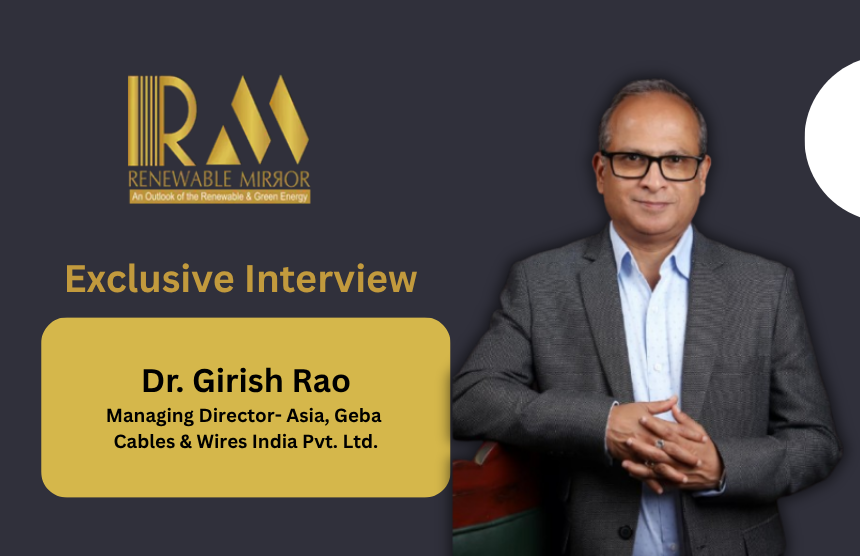1. Geba has evolved from its elevator cable heritage to a diversified solutions provider across solar, rail, wind, EVs, and data centers. How would you define Geba’s core identity in this expanded landscape?
Geba Cables & Wires India began its operations in Bangalore in 2010, initially focusing on elevator harness solutions. In 2012, its parent company, Gebauer + Griller, expanded its presence in the Indian market by investing in four new PV ribbon and interconnect lines—one of the first such initiatives in India at the time. This strategic move aligned with the country’s emerging solar industry and the growing demand for locally manufactured solar modules.
For nearly a decade, the Elevator and Solar sectors remained the core markets for Geba India. However, in line with the company’s growth strategy, it was later decided to diversify into the Rail, Wind, and Data Center segments. This expansion was a natural progression, given the similarities in skill sets and manufacturing processes required for cable assemblies across these industries.
2. With India achieving record solar capacity additions this year, how is the demand for your PV ribbons and DC cables evolving between rooftop and utility-scale projects?
Our PV ribbons and busbars are integral components of photovoltaic (PV) modules, and our direct customers are PV module manufacturers. It is ultimately the responsibility of these manufacturers to select and serve their end customers.
3. Geba offers wiring harnesses, machine wiring, controller harnesses, rolling-stock signaling, EV and solar DC harnesses, as well as complete electrification packages. How does your product architecture and assembly strategy differ across these
applications, and what systems do you use to manage complexity and ensure quality?
Our core strength lies in delivering reliable connectivity solutions tailored to our customers’ equipment. Achieving this requires deep domain knowledge and strong engineering expertise. We leverage our understanding of industry-specific applications and engineering principles to design and implement processes that consistently meet— and often exceed—our customers’ expectations.
4. In the EV segment, you provide battery-PDU interconnects, charging guns, and sockets. How do you ensure toptier safety and compliance (e.g., insulation, current ratings) while supporting rapid innovation and diverse OEM specifications?
In the electric vehicle (EV) sector, Geba offers comprehensive high-voltage interconnection solutions for both high and low current applications. Our key products include high-voltage connectors and harness components, high-voltage power distribution boxes, and complete interconnection systems.
To achieve lightweight and high-performance solutions, we utilize advanced manufacturing technologies such as ultrasonic welding and highspeed terminal punching.
Built on the foundation of the IATF 16949 quality management system, we have further strengthened our process controls through the implementation of the VDA system, MES (Manufacturing Execution System), automated testing, integrated electrical performance validation, and other modern quality assurance methods. Combined with a dust-free workshop and a state-of-the-art production environment, these practices ensure robust quality and reliability across all our EV products.
5. Geba’s website highlights its ‘bestin-class production and IT systems’ and ‘world-class testing facilities’ for ensuring safety and reliability. What specific testing protocols (e.g., flammability, flex life, signal integrity) are employed across product lines such as flat elevator cables, PV ribbons, and Connectors?
Every product that leaves our factory undergoes 100% testing to ensure it meets the highest standards of safety and performance. Each of our assembly lines is equipped with computerized, customized test jigs designed specifically for the product being manufactured.
Every unit must pass through this system and receive a “Test Pass” sticker before it proceeds to the packing stage. Depending on the customer’s application and requirements, we implement a range of tailored test protocols.
We take immense pride in our exceptional safety and quality record, which reflects our commitment to delivering reliable and defect-free solutions.
6. Geba recently inaugurated a new photovoltaic interconnect line at its Bengaluru facility. What were the key drivers behind this investment— domestic solar demand, export opportunities, or evolving customer requirements—and how does it align with your long-term solar strategy?
Previously, our PV interconnect business model faced challenges due to the influx of low-cost Chinese imports into the Indian solar market. This discouraged new investments by domestic manufacturers, resulting in significant idle production capacity across the industry.
However, the landscape began to shift in 2024, when the Indian government introduced a 5% import duty on PV ribbons and interconnect products. This policy change leveled the playing field and enabled us to compete more effectively with Chinese imports.
In parallel, there has been a surge in investments and expansions within the Indian PV module manufacturing sector. Recognizing this positive momentum, Geba made the strategic decision to invest in new production lines.
Today, we operate at a capacity of 2 GW and are continuing to invest further to support the growing demand and strengthen our position in the domestic solar supply chain.
7. REI 2025 in October will bring together key players in the renewable ecosystem. What innovations or solutions does Geba plan to showcase, and how will this platform help you connect with customers and strengthen your position in the solar and electrification space?
We always look forward to the Renewable Energy India (REI) Expo — a unique opportunity to connect with all our valued customers under one roof. While we won’t spill the details just yet, we warmly invite you to visit the Geba booth and experience firsthand how our solutions can bring added value to the Indian solar market. Exciting innovations await — see you there










